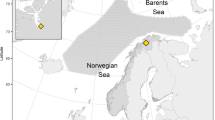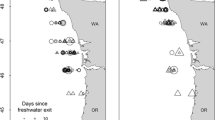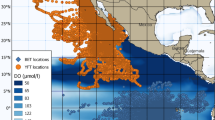Abstract
The timing of the juvenile Atlantic salmon ocean-entry is considered a critical stage in the species’ life-history. Entry into the ocean at suboptimal times can have negative survival impacts on entire smolt cohorts. Previous studies have identified smolt residency time in the Bras d’Or Lakes as highly variable and correlated with body condition. This study combines energetic modelling using Dynamic Energy Budget (DEB) theory with acoustic telemetry to mechanistically link smolt bioenergetics to their migration strategy within the Bras d’Or. This study examines two main questions: 1) what is the relationship between smolts’ bioenergetics and smolts’ migration strategy, and 2) what effect would warmer water temperature have on smolts’ energetic requirements? Simulation results indicate that smolts requiring more food are more likely to exit the Bras d’Or during the observation period. The results also suggest higher lake temperature would result in faster depletion of smolt energy reserves, which is predicted to favour smolts migrating to the ocean sooner.






Similar content being viewed by others
References
Amiro PG, Gibson AJF, Bowlby HD (2006) Atlantic Salmon (Salmo salar) overview for eastern Cape Breton, Eastern Shore, Southwest Nova Scotia and inner Bay of Fundy rivers (SFA19 to 22) in 2005. DFO Can Sci Advis Sec Res Doc. Doc. 2006/024
Bordeleau X, Hatcher BG, Denny S, Fast MD, Whoriskey FG, Patterson DA, Crossin GT (2018) Consequences of captive breeding: fitness implications for wild-origin, hatchery-spawned Atlantic salmon kelts upon their return to the wild. Biol Cons 225C:144–153
Brawn VM (1982) Behavior of Atlantic salmon (Salmo salar) during suspended migration in an estuary, sheet harbour, Nova Scotia, observed visually and by ultrasonic tracking. Can J Fish Aquat Sci 39:248–256
Brönmark C, Skov C, Brodersen J, Nilsspm AP, Hansson L (2008) Seasonal migration determined by a trade-off between predator avoidance and growth. PLoS One 3(4):e1957
Byron CJ, Pershing AJ, Stockwell JD, Xue H, Kocik J (2014) Migration model of post-smolt Atlantic salmon (Salmo salar) in the Gulf of Maine. Fish Oceanogr 23(2):172–189
Chaput G (2012) Overview of the status of Atlantic salmon (Salmo salar) in the North Atlantic and trends in marine mortality. ICES J Mar Sci 69(9):1538–1548
Committee on the Status of Endangered Wildlife in Canada (2010) Assessment and status report on the Atlantic salmon Salmo salar in Canada. Ottawa, ONhttp://www.sararegistry.gc.ca/document/default_e.cfm?documentID=2258. Accessed Apr 5 2017
Crossin GT, Hatcher BG, Denny S, Whoriskey K, Orr M, Penney A, Whoriskey FG (2016) Condition-dependent migratory behaviour of endangered Atlantic salmon smolts moving through an inland sea. Conserv Physiol 4:1–12
Davidsen JG, Daverdin M, Sjursen AD Rønning L, Arnekleiv JV, Koksvik JI (2014) Does reduced feeding prior to release improve the marine migration of hatchery brown trout Salmo trutta smolts? J Fish Biol 85(6):1992–2002
Dempson JB, Robertson MJ, Pennell CJ, Furey G, Bloom M, Shears M, Ollerhead LMN, Clarke KD, Hinks R, Robertson GJ (2011) Residency time, migration route and survival of Atlantic salmon Salmo salar smolts in a Canadian fjord. J Fish Biol 78:1976–1992
Duarte P, Meneses R, Hawkins AJS, Zhu M, Fang J, Grant J (2003) Mathematical modelling to assess the carrying capacity for multi-species culture within coastal waters. Ecol Model 168:109–143
Dunfield RW (1985) The Atlantic salmon in the history of North America. Can Spec Publ Fish Aquat Sci 80:181
Fauntleroy Watershed. Salmon profiles. (2017). Retrieved from: http://www.resizing.info/openphoto.php?img=http://www.fauntleroywatershed.org/education/images/salmon_profiles.jpg
Filgueira R, Chapman JM, Suski CD, Cooke SJ (2016) The influence of watershed land use cover on stream fish diversity and size-at-age of a generalist fish. Ecol Indic 60:248–257
Friedland KD, Reddin DG, Kocik JF (1993) Marine survival of north American and European Atlantic salmon effects of growth and environment. ICES J Mar Sci 50(4):481–492
Friedland KD, Hansen LP, Dunkley DA (1998) Marine temperatures experienced by post smolts and the survival of Atlantic salmon Salmo salar L., in the North Sea area. Fish Oceanogr 7:22–34
Friedland KD, Reddin DG, McMenemy JR, Drinkwater KF (2003) Multidecadal trends in north American Atlantic salmon (Salmo salar) stocks and climate trends relevant to juvenile survival. Can J Fish Aquat Sci 60:563–583
Friedland KD, Shank BV, Todd CD, McGinnity P, Nye JA (2014) Differential response of continental stock complexes of Atlantic salmon (Salmo salar) to the Atlantic multidecadal oscillation. J Marine Syst 133:77–87
Gross MR, Coleman RM, McDowall RM (1988) Aquatic productivity and the evolution of diadromous fish migration. Science 239:1–4
Gudjonsson S, Jonsson IR, Antonsson T (2005) Migration of Atlantic salmon, Salmo salar, smolt through the estuary area of river Ellidaar in Iceland. Environ Biol Fish 74:291–296
Gurbutt PA, Petrie B (1995) Circulation in the bras d’Or lakes. Estuar Coast Shelf Sci 41:611–630
Halfyard EA, Gibson AJF, Stokesbury MJW, Ruzzante DE, Whoriskey FG (2013) Correlates of estuarine survival of Atlantic salmon postsmolts from the southern upland, Nova Scotia, Canada. Can J Fish Aquat Sci 70:452–460
Hansen LP, Quinn TP (1998) The marine phase of the Atlantic salmon (Salmo salar) life cycle, with comparisons to Pacific salmon. Can J Fish Aquat Sci 55:104–118
Hansen LP, Holm M, Holst JC, Jacobsen JA (2003) The ecology of post-smolts of Atlantic salmon. In: Mills D (ed) Salmon at the edge, Blackwell Science, Oxford, pp 25–39
Hvidsten NA, Jensen AJ, Rikardsen AH, Finstad B, Aure J, Stefansson S, Fiske P, Johnsen BO (2009) Influence of sea temperature and initial marine feeding on survival of Atlantic salmon Salmo salar post-smolts from the rivers Orkla and Hals, Norway. J Fish Biol 74:1532–1548
Imholt C, Malcolm IA, Bacon PJ, Gibbins CN, Soulsby C, Miles M, Fryer RJ (2011) Does diurnal temperature variability affect growth in juvenile Atlantic salmon Salmo salar. J Fish Biol 78:436–448
Jones DA, Bergman E, Greenberg L (2015) Food availability in spring affects smolting in brown trout (Salmo trutta). Can J Fish Aquat Sci 72:1694–1699
Jonsson B, Jonsson N (2004) Factors affecting marine production of Atlantic salmon Salmo salar. Can J Fish Aquat Sci 61:2369–2383
Jonsson B, Jonsson N (2009) A review of the likely effects of climate change on anadromous Atlantic salmon Salmo salar and brown trout Salmo trutta with particular reference to water temperature and flow. J Fish Biol 75:2381–2447
Jonsson B, Ruud-Hansen J (1985) Water temperature as the primary influence on timing of seaward migrations of Atlantic salmon (Salmo salar) smolts. Can J Fish Aquat Sci 42:593–595
Kearney M (2012) Metabolic theory, life history and the distribution of a terrestrial ectotherm. Funct Ecol 26:167–179
Kennedy RJ, Crozier WW (2010) Evidence of changing migratory patterns of wild Atlantic salmon Salmo salar smolts in the river bush, Northern Ireland, and possible associations with climate change. J Fish Biol 76:1786–1805
Klemetsen A, Amundsen PA, Dempson JB, Jonsson B, Jonsson N, O’Connell MF, Mortensen E (2003) Atlantic salmon Salmo salar L., brown trout Salmo trutta L. and Arctic charr Salvelinus alpinus (L.): a review of aspects of their life histories. Ecol Freshw Fish 12:1–59
Kooijman SALM (2010) Dynamic energy budget theory for metabolic organization. Cambridge University Press
Lacroix GL, Knox D, Stokesbury MJW (2005) Survival and behaviour of post-smolt Atlantic salmon in coastal habitat with extreme tides. J Fish Biol 66:485–498
Lans L, Greenberg LA, Karlsson J, Calles O, Schmitz M, Bergman E (2011) The effects of ration size on migration by hatchery-raised Atlantic salmon (Salmo salar) and brown trout (Salmo trutta). Ecol Freshw Fish 20:548–557
Larsen PS, Filgueira R, Riisgård HU (2014) Somatic growth of mussels Mytilus edulis in field studies compared to predictions using BEG, DEB, and SFG models. J Sea Res 88:100–108
Lika K, Kearney MR, Freitas V, van der Veer HW, van der Meer J, Wijsman JWM, Pecquerie L, Kooijman SALM (2011) The “covariation method” for estimating the parameters of the standard dynamic energy budget model I: philosophy and approach. J Sea Res 66:270–277
McCormick SD, Saunders RL (1987) Preparatory physiological adaptations for marine life of salmonids: osmoregulation, growth. and metabolism Am Fish Soc Symp 1:211–229
McCormick SD, Hansen LP, Quinn TP, Saunders RL (1998) Movement, migration, and smolting of Atlantic salmon (Salmo salar). Can J Fish Aquat Sci 55:77–92
McMillan, J, Trowse, G, Schillinger, D, Hay, A, Hatcher, B (2012) Cape Breton resource assessment. Offshore Energy Research Association of Nova Scotia (OERA), Halifax NS
Mills KE, Pershing AJ, Sheehan TF, Mountain D (2013) Climate and ecosystem linkages explain widespread declines in north American Atlantic salmon populations. Glob Change Biol 19:3046–3061
Minister’s advisory committee on Atlantic salmon (2015) A special Report on Wild Atlantic salmon in Eastern Canada. Department of Fisheries and Oceans http://www.publications.gc.ca/site/eng/9.802762/publication.html cited. Accessed Apr 5 2017
Moore A, Potter ECE, Milner NJ, Bamber S (1995) The migratory behaviour of wild Atlantic salmon (Salmo salar) smolts in the estuary of the river Conwy, North Wales. Can J Fish Aquat Sci 52:1923–1935
Moriarty PE, Byron CJ, Pershing AJ, Stockwell JD, Xue H (2016) Predicting migratory paths of post-smolt Atlantic salmon (Salmo salar). Mar Biol 163:74
Otero J, L'Abée-Lund JH, Castro-Santos T, Leonardsson K, Storvik GO, Jonsson B, Dempson B, Russell IC, Jensen AJ, Baglinière JL, Dionne M, Armstrong JD, Romakkaniemi A, Letcher BH, Kocik JF, Erkinaro J, Poole R, Rogan G, Lundqvist H, MacLean JC, Jokikokko E, Arnekleiv JV, Kennedy RJ, Niemelä E, Caballero P, Music PA, Antonsson T, Gudjonsson S, Veselov AE, Lamberg A, Groom S, Taylor BH, Taberner M, Dillane M, Arnason F, Horton G, Hvidsten NA, Jonsson IR, Jonsson N, McKelvey S, Naesje TF, Skaala Ø, Smith GW, Saegrov H, Stenseth NC, Vøllestad LA (2014) Basin-scale phenology and effects of climate variability on global timing of initial seaward migration of Atlantic salmon (Salmo salar). Glob Change Biol 20:61–75
Parrish DL, Behnke RJ, Gephard SR, McCormick SD, Reeves GH (1998) Why aren’t there more Atlantic salmon (Salmo salar)? Can J Fish Aquat Sci 55:281–287
Petrie B, Bugden G (2002) The physical oceanography of the bras d’Or lakes. Proc NS Inst Sci 42(1):9–36
Remen M, Oppedal F, Imsland AK, Olsen RE, Torgersen T (2013) Hypoxia tolerance thresholds for post-smolt Atlantic salmon: dependency of temperature and hypoxia acclimation. Aquaculture 416:41–47
Renkawitz MD, Sheehan TF, Dixon HJ, Nygaard R (2015) Changing trophic structure and energy dynamics in the Northwest Atlantic: implications for Atlantic salmon feeding at West Greenland. Mar Ecol Prog Ser 538:197–211
Riley WD (2007) Seasonal downstream movements of juvenile Atlantic salmon, Salmo salar L., with evidence of solitary migration of smolts. Aquaculture 273:194–199
Rosland R, Strand Ø, Alunno-Bruscia M, Bacher C, Strohmeier T (2009) Applying dynamic energy budget (DEB) theory to simulate growth and bio-energetics of blue mussels under low seston conditions. J Sea Res 62:49–61
Rowe DK, Thorpe JE (1990) Differences in growth between maturing and non-maturing male Atlantic salmon, Salmo salar L., parr. J Fish Biol 36:643–658
Saraiva S, van der Meer J, Kooijman SALM, Sousa T (2011) Modelling feeding processes in bivalves: a mechanistic approach. Ecol Model 222:514–523
Schulte-Hostedde AI, Zinner B, Millar JS, Hickling GJ (2005) Restitution of mass-size residuals: validating body condition indices. Ecology 86:155–163
Shaw J, Piper DJW, Taylor RB (2002) The geology of the bras d’Or lakes, Nova Scotia. Proc NS Inst Sci 42:127–147
Sousa T, Domingos T, Poggiale JC, Kooijman SALM (2010) Dynamic energy budget theory restores coherence in biology. Phil Trans R Soc B 365:3413–3428
Strain PM, Yeats PA (2002) The chemical oceanography of the bras D’Or lakes. Proc NS Inst Sci 42:37–64
Thorstad EB, Whoriskey F, Uglem I, Moore A, Rikardsen AH, Finstad B (2012) A critical life stage of the Atlantic salmon Salmo salar: behaviour and survival during the smolt and initial post-smolt migration. J Fish Biol 81:500–542
Tremblay MJ, Paul K, Lawton P (2005) Lobsters and other invertebrates in relation to bottom habitat in the bras d’Or lakes: application of video and SCUBA transects. Can Tech Rept Fisheries Aquat Sci 2645
Vainikka A, Huusko R, Hyvärinen P, Korhonen PK, Laaksonen T, Koskela J, Vielma J, Hirvonen H, SalminenM (2012) Food restriction prior to release reduces precocious maturity and improves migration tendency of Atlantic salmon (Salmo salar) smolts. Can J Fish Aquat Sci 69:1981–1993
Wysujack K, Greenberg LA, Bergman E, Olsson IC (2009) The role of the environment in partial migration: food availability affects the adoption of a migratory tactic in brown trout Salmo trutta. Ecology Freshwater Fish 18:52–59
Yang B, Sheng J, Hatcher BG, Petrie B (2007) Numerical study of circulation and temperature-salinity distributions in the bras d’Or lakes. Ocean Dynam 57:245–268
Zydlewski GB, Haro A, McCormick SD (2005) Evidence for cumulative temperature as an initiating and terminating factor in downstream migratory behavior of Atlantic salmon (Salmo salar) smolts. Can J Fish Aquat Sci 62:68–78
Acknowledgements
Financial support for this study was provided by the Aboriginal Fund for Species at Risk to S.D., the Natural Sciences and Engineering Research Council of Canada’s (NSERC), and the Canada Foundation for Innovation’s awards to the Ocean Tracking Network. Additional support was provided by a Natural Sciences and Engineering Research Council of Canada Discovery Grant to G.T.C. We thank the staff at the Margaree Fish Hatchery (Nova Scotia Department of Fisheries and Aquaculture) for assistance in the collection of growth data for Middle River parr; the Unama’ki Institute of Natural Resources for their collaboration with the smolt tagging project; and the Bras d’Or Institute (Cape Breton University) for maintenance of the receiver array and the collection of tag tracking data as well as oceanographic measurements.
Author information
Authors and Affiliations
Corresponding author
Rights and permissions
About this article
Cite this article
Strople, L.C., Filgueira, R., Hatcher, B.G. et al. The effect of environmental conditions on Atlantic salmon smolts’ (Salmo salar) bioenergetic requirements and migration through an inland sea. Environ Biol Fish 101, 1467–1482 (2018). https://doi.org/10.1007/s10641-018-0792-5
Received:
Accepted:
Published:
Issue Date:
DOI: https://doi.org/10.1007/s10641-018-0792-5




